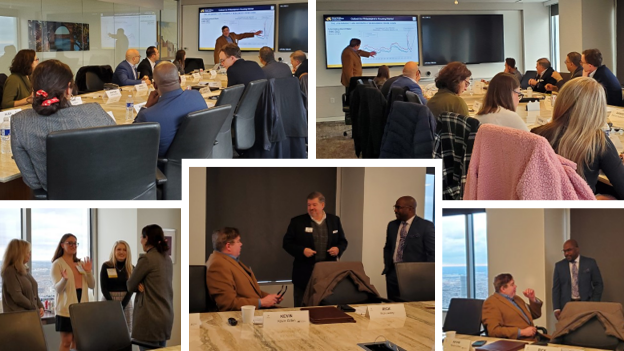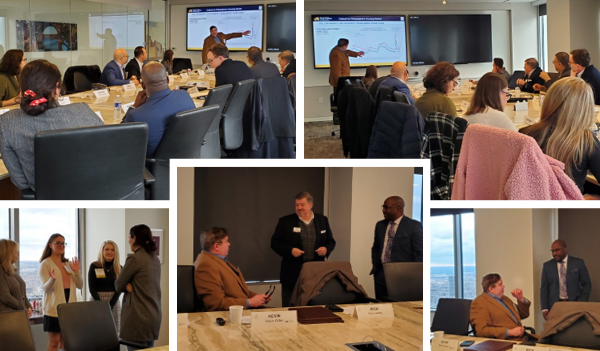May 2023 Philadelphia Mastermind Group Key Take Aways!
• The Amtrak renovation of 30th Street Station is a 50-year P3 / Public-Private Partnership. (Ryan Johnson – Plenary Group)
• Gilbane is working on the design and construction and Plenary Group is a global infrastructure development company that specializes in P3 contracts and is overseeing the project from the developer’s point of view. (Scott Mucci – Gilbane Building Company, Ryan Johnson – Plenary Group)
• Amtrak did a district plan which started in 2015 and is a full overhaul of all of their facilities. The redevelopment of the 30th Street Station is part of that. (Scott Mucci – Gilbane Building Company)
• Phase one of the project is the redevelopment of the station itself. (Scott Mucci – Gilbane Building Company)
• It’s a 50-year design, build, finance, operate and maintain public-private partnership structure for the facility itself. (Scott Mucci – Gilbane Building Company)
• Covid delayed closing until August of 2021 and they started on September 1st, 2021, when Hurricane Ida caused damage to the station . (Scott Mucci – Gilbane Building Company)
• Public-private partnerships (P3) in the rest of the world are narrowly defined as the transfer of risk of design, build, finance, etc from the public sector to the private sector for a long period of time. In the US, it can mean anything, but this project follows the international model. (Ryan Johnson – Plenary Group)
• Unlike a typical construction project or public facility project, there are 3 partners. Gilbane, Johnson Controls and Advantage Airport Group. (Ryan Johnson – Plenary Group)
• The best way to conceptualize this is not as one gigantic project but rather as ten $50 million projects happening in the same space at the same time with millions of passengers moving through the space. Very complicated logistically. (Ryan Johnson – Plenary Group)
• In addition to some deferred maintenance issues, there is the typical redevelopment and modernization of the station. (Scott Mucci – Gilbane Building Company)
• Hope to create community fabric for the station and the retail and tie it into the surrounding area. (Scott Mucci – Gilbane Building Company)
• They created a stand alone entity called Plenary Infrastructure Philadelphia, which is the developer for the project. (Ryan Johnson – Plenary Group)
• The P3 approach allows for a more cost-certain approach to ensure the building is well maintained for the next 50 years. (Ryan Johnson – Plenary Group)
• Hoping to reactivate the north waiting room, which is currently under-utilized. (Scott Mucci – Gilbane Building Company)
• Ticket window has not been updated in a long time. (Scott Mucci – Gilbane Building Company)
• Market Street Plaza on the South side of the building is currently a circulation path and they’re intending to close that down and bring the connectivity into the station. They hope to create more of a sense of gathering from a community perspective. (Scott Mucci – Gilbane Building Company)
• There will be vendors and carts outside with grab-and-go options. (Scott Mucci – Gilbane Building Company)
• Passenger pick up and drop off area will not be changed. (Scott Mucci – Gilbane Building Company)
• Plan to reinvigorate the south concourse, making it a place to go even for people not using the station. The goal is to think of the station as a place, not just a point to pass through. (Scott Mucci – Gilbane Building Company, Ryan Johnson – Plenary Group)
• They want to bring some of the retail into the main concourse to bolster that sense of space. (Scott Mucci – Gilbane Building Company)
• They are renovating the corporate offices (5 floors above the station), which is the first major update in 30 years. (Scott Mucci – Gilbane Building Company)
• They will be repairing and updating many of the bones of the station, including electrical, lighting, HVAC, roof, elevators, etc. Large parts of the work that you may never even see. P3 project allows this to happen. (Scott Mucci – Gilbane Building Company, Ryan Johnson – Plenary Group)
• They are building a memorial to William H. Gray. His son has a foundation and they are doing a call for artists to get a fitting tribute to him there. (Scott Mucci – Gilbane Building Company)
• The station is historically designated. They are looking into the possibility of tax credits, but nothing is being used in the plan now. (Ryan Johnson – Plenary Group)
• There is a complex model that separates Amtrak from the private equity. It’s more like a credit-tenant lease. (Ryan Johnson – Plenary Group)
• Built out temporary space for employees who were using the offices in the station. (Scott Mucci – Gilbane Building Company)
• The deal included a very involved escalation clause. Need a really solid balance sheet to demonstrate you’re going to be there and have financial strength to resolve issues throughout the length of the 50 year contract. (Ryan Johnson – Plenary Group)
• The bus terminal portion is not part of the current project. May require a citywide push. (Scott Mucci – Gilbane Building Company)
• There is nothing currently regarding plans for a tunnel to connect to the subway station, but Amtrak is looking into it. (Scott Mucci – Gilbane Building Company)
• The façade is not changing. (Ryan Johnson – Plenary Group)
• Amtrak is new to the sustainability conversation, so requirements were limited but they continue to have conversations about it. (Ryan Johnson – Plenary Group)
• Though they can’t build future technology into the deal, they will review every 5 years and make a more specific lifecycle plan. (Scott Mucci – Gilbane Building Company)
• The scope of the project is inside the station, so parking isn’t being addressed. Will be possible to change their minds as they consider the North expansion. (Scott Mucci – Gilbane Building Company)
• SEPTA uses the station, but has no input into the project. They are sub-tenants. (Scott Mucci – Gilbane Building Company, Ryan Johnson – Plenary Group)
• There is an intense focus on distressed real estate. (Bart Mellits – Ballard Spahr)
• There are lots of maturities coming due. People are still saying it’s not going to be that long-lived, but it’s hard to see a simple solution. (Bart Mellits – Ballard Spahr)
• There is a lot going on in life sciences, but anything in traditional office is tough. (Bart Mellits – Ballard Spahr)
• The fashion district’s position on the policy restricting teenagers from the area is that it’s a citywide issue. It’s a problem without a good solution. (Sara McCormick – Ballard Spahr)
• The leasing market is seeing a slight increase in momentum. (Christian Dalzell – Counter Management)
• Transactions are slowed because buyers and sellers are too far apart. (Christian Dalzell – Counter Management)
• A lot of people can’t afford to buy a house and a lot of tenants and renewals have locked in for 2 years. There has been a large increase in 2-year leases. (Christina Lutz – Counter Management)
• A lack of demand, general inflation and interest rates have been killing everything. (Ed Opall – EisnerAmper)
• Everyone is using less space in their offices and companies are downsizing. (Ed Opall – EisnerAmper)
• Investors are waiting for things to fall out but there are a few opportunities. (Joseph Viturello – PernaFrederick Commercial Real Estate)
• Retail is doing well lately and there is a massive demand on retail leasing. Lots of empty storefronts are leased but stuck with zoning issues. (Joseph England – EisnerAmper LLP, Dennis Carlisle – OCF Realty)
• There have been some conversions of B/C office buildings to multi-family in the past. (Joseph Viturello – PernaFrederick Commercial Real Estate)
• It’s difficult to convert old office buildings into life sciences. (Bart Mellits – Ballard Spahr)
• It’s difficult to be productive remotely for many businesses. In many cases, employees are getting work done but aren’t thriving. Experienced people tend to be fine, but many younger people are missing out and don’t even know it. It’s difficult to keep employees if they’re forced to come into the office. Indian offices have grown because it’s cheaper than working with local remote employees. (Jim Karmolinski – Kelly Maiello Architects, Joseph England – EisnerAmper LLP, Ed Opall – EisnerAmper)
• Some contracts have pushed back. Everyone is trying to figure things out before taking action. (Lorena Rodriguez – Talson Solutions)
• Many smaller firms are getting gobbled up by larger firms. (Sean Pulsifer – Ballinger)
• Dollars are starting to stabilize but supply chains are still a mess. (Scott Mucci – Gilbane Building Company)
• There is commercial leasing activity for everything that’s not an office. (Dennis Carlisle – OCF Realty)
• There is interest from developers on sites, but everyone is being a little more picky. (Dennis Carlisle – OCF Realty)
• There are concerns that the city council and mayoral races will go to candidates that are not favorable to development. (Dennis Carlisle – OCF Realty)
• Zoning overlays have been added to an area of North Philadelphia that will make projects difficult. Most areas of the city have zoning overlays. (Dennis Carlisle – OCF Realty)
• The insurance market continues to be difficult for commercial properties. (Matt Musilli – Johnson, Kendall & Johnson)
• Many private developers have put a halt on new construction in PA and NJ and are pivoting to distressed properties. (Matt Musilli – Johnson, Kendall & Johnson)






Recent Comments